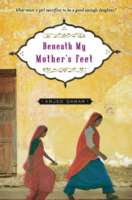
Beneath My Mother’s Feet
Written by Amjed Qamar
Atheneum, 2008, 198 pp.
ISBN: 978-1416947288
Nazia, a fourteen-year-old girl living in Karachi, Pakistan, is secure in her life as a student, a sister, a friend and most of all as a daughter. She belongs to an uneducated working class urban family, where the father, the sole breadwinner, works long hours as a laborer and struggles to put food on the table and the mother augments the income by sewing clothes for the richer ladies of the society. Nazia’s future is safe because she is betrothed to a cousin and will be married within a year. Her mother has collected her jaheez (dowry) slowly and painstakingly until it is almost complete. Nazia loves studying and goes to school regularly where she excels. This secure existence is shattered when her father is in an accident at his place of work and refuses to go back even though he is not hurt badly, her older brother robs them of her dowry and runs away, and her uncle/father-in-law refuses to accept her as the dowry is gone. The responsibility of becoming the breadwinner falls on the women of the house and she and her mother are forced to approach a wealthier household in Karachi to become Masi’s (cleaning ladies) to keep a roof over their heads and feed themselves as well as the younger members of the family. Worst of all she is required to quit school to perform menial duties that are embarrassing for her. Nazia, however, does not let this situation overcome her optimism for a better future.
This novel illuminates the universal concepts of struggle for survival and sacrifice, and elaborates on the impact of women’s influence in a patriarchal society. The men in general, women of the rich households, and the mother of a secondary protagonist are presented as villainous. This story articulates Nazia’s feelings of mistrust for the men in her family through the unfolding of the actions of the story. The reflection of mothers throughout the sequence of events is negative. The author questions the concept of motherhood in Islam. Islamic thought on women, specifically mothers, is that of extreme respect and veneration, to the degree that paradise exists under the feet of a mother. Both of the mothers in the book, on the other hand, take advantage of their children by not taking care of their children’s needs and forcing their children to work – Nazia’s mother by making her leave school and work and the other mother by making all of her very young children toil at different households where she visits once a month to collect the fruits of their labor. The author, Amjed Qamar, tells the story as an insider who might have witnessed such events unfold. The coming of age of a young girl in such extraordinary circumstances is narrated believably.
Throughout the narrative religion has a presence of being ingrained in the very fabric of the protagonist’s life. Nazia’s faith and her internal integrity seem to stem from her religious beliefs, which are unshakable even after going through so much, to the degree of losing everything she holds dear. Obedience to her mother’s will also reveals conviction in her religious values. She is depicted as performing her prayers of the day after Wuzu (ritualistic cleansing before prayers), as a way of life. She awaits Azan (call to prayers) and demonstrates guilt if her innumerable chores cause her to miss any of her prayers. Islamic way of greetings, exclamation, and respect at the mention of Prophet Mohammad’s (SAW) name are also frequent within the dialogue of the various characters. Nazia’s resistance to her present circumstances and her argument about education as necessary for a better way of life are also her rights under Islam and are ultimately acknowledged by her family.
The story touches on aspects of Pakistani culture that might be true in some instances but cannot be taken as representative of the whole of the society. While attention is given to women’s empowerment and the power of choice and education, this book reinforces stereotypes of early marriages, the requirement for dowry, and child labor in Pakistani/Muslim societies. The intended audience in the U.S. and other English-speaking countries is exposed to a narrow diversity within Pakistani society, which encompasses only the rich and the very poor and ignores the middle class. It is authentic in the incorporation of religion in everyday life but the author has fashioned an extremely pessimistic portrayal of men and mothers, which negates the religious foundations. This novel can be read along with research on ways of life of Pakistani people and Islamic religion. Variations of some of the same thematic threads can be found in other novels set in Pakistan by authors outside of the culture such as Iqbal (Francesco D’Adamo, 2003), Shabanu: Daughter of the Wind; Haveli; The House of the Djinn; and Under the Persimmon Tree, (Suzanne Staples 1989, 1995, 2008, & 2005).
Seemi Rain, University of Arizona, Tucson, AZ
WOW Review, Volume I, Issue 2 by Worlds of Words is licensed under a Creative Commons Attribution-NonCommercial-ShareAlike 4.0 International License. Based on work at https://wowlit.org/on-line-publications/review/i-2/

2 thoughts on “WOW Review Volume I Issue 2”
Comments are closed.